FEATURE Cyclone Amphan reminds us why mangrove conservation is essential

INDIA – “Before 2009, we had never planted a mangrove before, we were working on wildlife and tigers. Cyclone Aila was an eye-opener for us ﹘ whatever you do in the Sundarbans, it has to be mangrove conservation in essence. If the mangroves are not there, the wildlife won’t be there, the people won’t be there, the delta won’t be there.” Ajanta Dey, Joint Secretary and Program Director, Nature Environment and Wildlife Society (NEWS), a conservation NGO working on ecology, sustainable livelihood and natural resource management in the Sundarbans area of West Bengal said, days after the state was ravaged by Cyclone Amphan, one of the worst cyclones, since 1737, some have claimed, plunging many regions into a power blackout. Jim Enright, Community-based Ecological Mangrove Restoration (CBEMR) trainer and former Asia coordinator, Mangrove Action Project (MAP), an organization working on mangrove restoration, education and advocacy across the globe, explained MAP’s CBEMR model, which involves community buy-in from the inception of the program to better understand their needs and abilities. “The community is central to the mangroves. They live in the mangroves, they depend on the mangroves, their livelihoods are connected to the mangroves. If they don’t have full ownership, it’s never going to work. This is again why we observe many government projects failing, because they never involve the local people in the decision-making process or long-term protection.” he says. READ MORE GLOBAL Momentum Growing Globally for Using Marine Protections to Address Climate Change
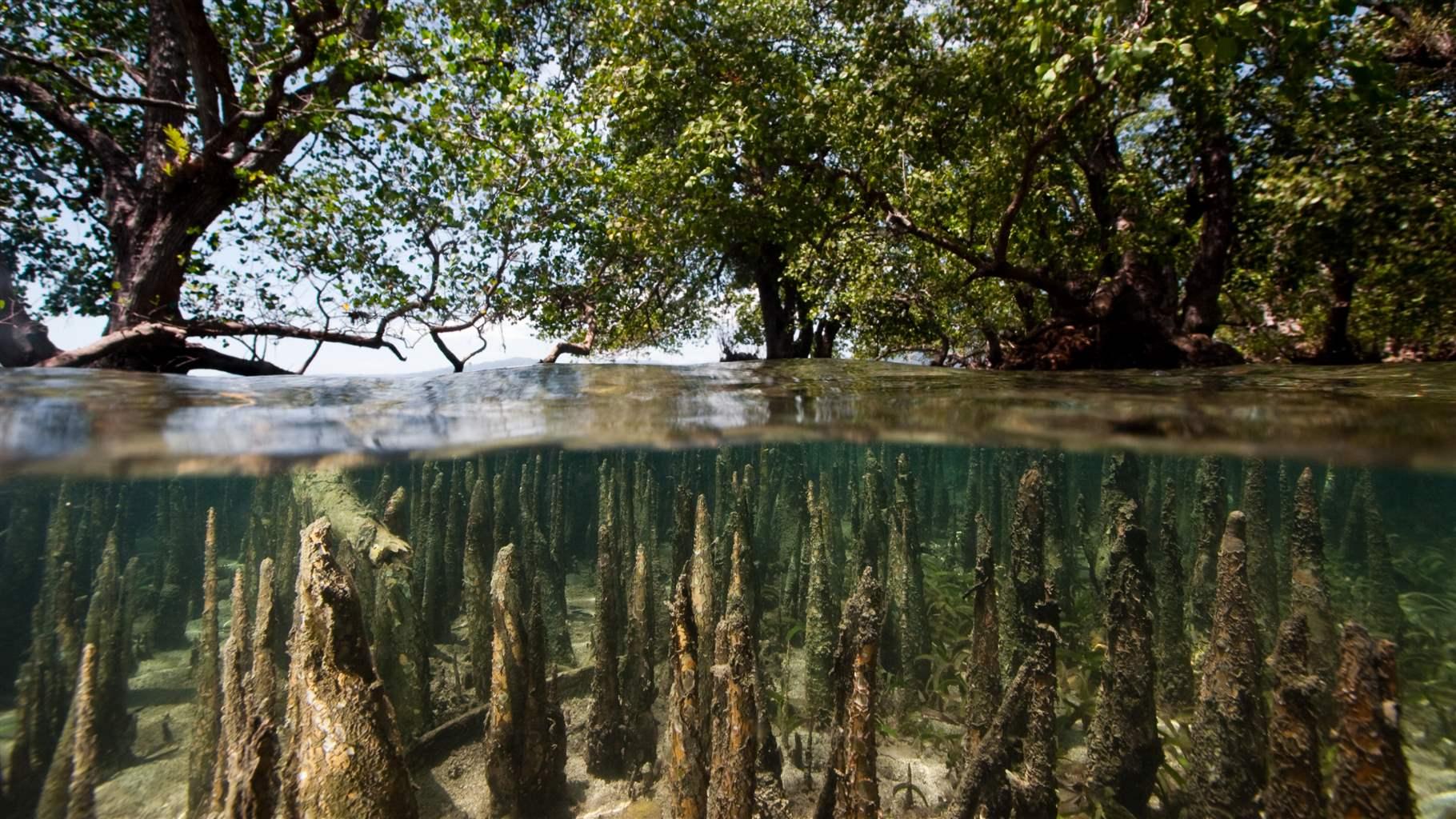
GLOBAL – This year, the 197 Parties to the Paris Agreement are updating their domestic climate commitments, known as Nationally Determined Contributions (NDCs), to reduce global emissions and climate change impacts. Science tells us that countries need to step up the ambition within these NDCs, and within each subsequent revision every 5 years going forward, in order to reduce greenhouse gas emissions and bring the world on track to meet the goals of the Paris Agreement. Recognition is growing across governments that nature-based solutions, which the International Union for Conservation of Nature defines as “actions to protect, sustainably manage, and restore natural or modified ecosystems,” can be a bigger part of the solution to climate change. The degree to which different nature-based solutions mitigate and build resilience to climate change varies but, nonetheless, policymakers are becoming increasingly aware that they are an underutilized tool. For example, some countries could protect and restore coastal wetlands, such as mangrove, seagrass and saltmarsh habitats, a move that could safeguard the range of benefits these habitats provide to people and nature. READ MORE AFRICA Supporting sustainable seaweed farming for East Africa’s coastal communities
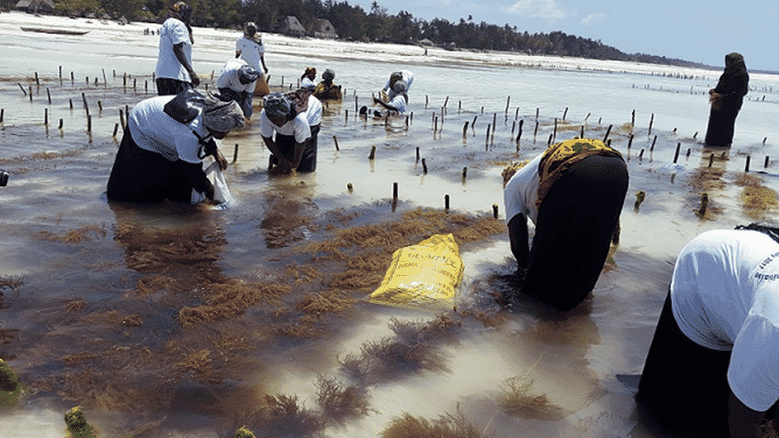
TANZANIA – Climate change and unsustainable practices are threatening seaweed farming in Tanzania, an industry that employs over 25,000 farmers, of whom around 80 percent are women. To help address these challenges, The Nature Conservancy is partnering with Cargill, local governments and researchers to empower communities through increased productivity, environmental training and mentorship. Along the Tanzanian coastline, seaweed aquaculture is an important industry to coastal women and also serves as an alternative livelihood to overharvested local fisheries. However, Tanzanian seaweed aquaculture has been stagnating recently, due to issues that include changing water-quality conditions and poor seedstock. Additionally, unsustainable farming practices damage sensitive coastal habitats. That said, when practiced well, seaweed aquaculture has the potential to be ecologically restorative and provide ecosystem services, while still producing a marketable product. To help address these roadblocks to sustainability, my team at The Nature Conservancy and our partners at Cargill are launching a new community-empowerment and environmental-training programme in Tanzania. This partnership will be a collaboration between us, Cargill’s Red Seaweed Promise, local suppliers, government partners and researchers to work with seaweed farmers on Unguja and Pemba Islands, part of Tanzania’s Zanzibar Archipelago. By working with villages, we will be able to host farmer training workshops and build local leadership capacity via mentoring programmes. This mentorship will build much-needed local capacity and ensure a continued technical presence. READ MORE
ASIA Neykurendhoo Mangrove Forest under threat!

MALDIVES – Neykurendhoo is home to one of the biggest mangrove forests in the Maldives which is now under the threat of being critically damaged. The mangove in the island of HDh. Neykurahdoo is one of the biggest in the country. But today we are faced with the stark reality that this natural gift for us might be taken away from us. The island’s council left no stones unturned in their attempt to highlight this concerning outturn to the relevant authorities. Photos of the disintegrating mangrove that has been circulated in social media platforms accentuate the graveness of its condition. In December 2018, President Ibrahim Mohamed Solih pledged to protect and conserve H.dh Neykurendhoo’s mangrove forest and wetland as per his 100 day pledge to conserve– in accordance with international standards–at least one island, one reef, and one wetland in each atoll. READ MORE
Civil war didn’t hurt this Sri Lankan mangrove forest, but shrimp farming might

SRILANKA – The Vidattaltivu coastal belt in Sri Lanka’s north was once home to the marine unit of the Tamil Tiger guerrilla group, known as the “Sea Tigers.” From here, the group launched explosive-laden suicide boats in attacks against the much more powerful fighter vessels of the country’s naval forces. The area’s lush mangroves proved an effective hiding place for storing explosives. More than a decade after the end of the civil war, the ecology of this picturesque nature reserve is under threat: there are plans to set up a shrimp aquaculture park here, which environmentalists have blasted as “environmental suicide.” Sri Lanka has a bitter history of shrimp farms going wrong. In the 1980s, large swaths of mangroves in the northwestern coast were cleared to farm shrimps for export. But frequent outbreaks of disease led to about 90% of the shrimp farms being abandoned. READ MORE
Meet The Man Who Spent Time With The Mysterious Mangrove Tigers

BANGLADESH – Over the years, few outsiders have dared venture into the beautiful yet terrifying terrain of the famous Swamp tigers. This Bengal tiger population inhabits the mysterious mangrove forests of the Sundarbans on the delta along the Bay of Bengal in India and Bangladesh. Throughout history, these tigers have inspired the awe. They have been revered for their enigmatic nature and ability to inhabit a land where everyday life is a constant struggle. These tigers have also earned a reputation as “man-eaters” but that remains a debatable issue. The world’s only tiger population to inhabit the mangroves, the lives of the Sundarbans tigers are shrouded in secrecy. Even today, a lot remains undiscovered about them. The harsh nature of their unique habitat hinders most from studying these tigers in detail. But one man, an award-winning wildlife cameraman, Mike Herd, was not to be stopped. His first glimpse of a stunning male Sundarbans tiger along the bank of a river enticed him enough to dedicate nearly half a year to filming these tigers. Without paying any heed to warnings about the alleged “man-eaters,” he decided to enter the home turf of these tigers in the year 2000 in the Sundarbans forests of Bangladesh. His dedication, fearlessness, patience, and talent led to the production of the multi-award winning “Swamp Tigers” documentary. To this day, “Swamp Tigers” continues to thrill viewers by bringing them face to face with the legendary Sundarbans tigers! World Atlas had the privilege of speaking with Mike Herd, the first person in the world to film the elusive Sundarbans tigers. READ MORE
Oil slick threatens Philippine mangrove forest recovering from earlier spill

PHILLIPINES – An oil spill on July 3 threatens a mangrove forest on the Philippine island of Guimaras, an area only just recovering from the country’s largest spill in 2006. This latest spill stems from an explosion onboard a floating power barge in the 13-kilometer (8-mile) waterway between the city of Iloilo and Guimaras Island. Operator AC Energy Inc. said the incident spilled 48,000 liters (12,700 gallons) of fuel oil into the Iloilo River and its tributaries before being contained eight hours later. But the Philippine Coast Guard said around 251,000 liters (66,300 gallons) of oil had spread around the waterway. The day after, July 4, the Coast Guard estimated it had collected 130,000 liters (34,300 gallons) of oil. Some of the oil was swept out of the containment area by strong waves and carried across to communities in Guimaras. “The root cause has yet to be determined,” AC Energy said in a statement. “But initial findings reveal that the discharge is due to the ignition of fuel oil in storage which ruptured the barge’s fuel tank.” READ MORE
Overlooked Methane Emissions Can Halve Climate Benefits of Subtropical Mangrove Wetlands

HONG KONG – An international collaborative study led by Professor Derrick Yuk Fo Lai at The Chinese University of Hong Kong (CUHK), joined by top-tier scientists from around the world, has discovered that sustained methane emissions from the subtropical estuarine mangroves can reduce its climatic cooling effects by over 50%, over a period of 20 years. The team produced the world’s first-ever multi-year dataset of ecosystem-scale methane emissions from a subtropical estuarine mangrove based on the data collected at Mai Po Nature Reserve in Hong Kong, which points out that global warming and greater river runoff may lead to increasing methane emissions. The findings have recently been published in Global Change Biology. Vegetated coastal wetlands such as mangroves and salt marshes sequester more carbon than any other ecosystems. They exhibit high rates of photosynthetic carbon dioxide uptake and sediment trapping, leading to significant carbon storage in the ecosystem and hence reduced accumulation of carbon dioxide in the atmosphere. The potential of managing this “blue carbon” for climate change mitigation has received increasing attention in recent years in the international community READ MORE AMERICAS Mangrove protection, Caribbean coral loss, dam development and more
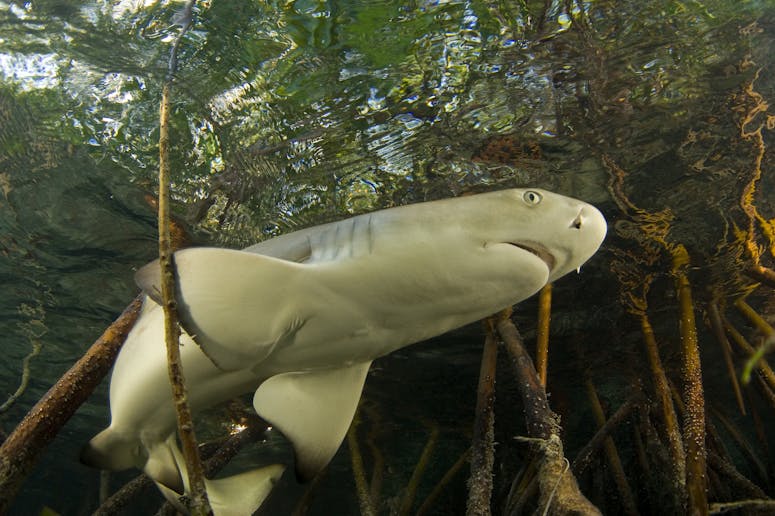
USA – More than 31 million people worldwide live in regions that are extremely vulnerable to sea-level rise and hurricanes or tropical cyclones. According to a new study, mangroves and coral reefs could help protect more than a quarter of people at risk by serving as a buffer between coastal communities and ocean waves or flooding, and by significantly reducing erosion. Conservation International scientists Dave Hole, Will Turner and Mariano Gonzalez-Roglich looked at mangrove forests and coral reefs situated near coastal populations around the world. They found that communities across Central America, the Caribbean, Eastern Africa, Southeast Asia and the South Pacific region stand to benefit the most from the conservation of these coastal ecosystems. Based on a range of economic and other societal factors, these communities have fewer opportunities to adapt via other means, such as building sea walls or buying insurance. READ MORE
25 million gallons of Longboat sewage spill onto mangrove habitat

USA – More than 25 million gallons of sewage spilled onto the shoreline area of Longbar Point in West Bradenton from a ruptured wastewater pipe that carries all of Longboat Key’s wastewater to the mainland. Longboat Key Town Manager Tom Harmer said staff and state and county agencies will investigate the exact cause of the break, the time it began and the extent of the spill and any incursion into Sarasota Bay. The area of the spill is in the mangrove habitat that forms a buffer between the bay and the mainland and is on property owned by developer Carlos Beruff. Harmer said Longboat staff was aware of anomalies and disparities in what was shown being pumped at Longboat Key lift stations and what was registering at Manatee County’s wastewater facility on the mainland. Manatee County facility workers first noticed possible issues on June 17, and communicated with Longboat staff over the next two weeks. Initially, Longboat believed it was a meter or equipment issue at the pumping or treatment station. It wasn’t until June 29 that the spill was discovered by Manatee employees after they inspected the area that the pipe traverses. The break in the pipe was discovered and repaired the same day by the town’s emergency contractors. It is unknown at this time how much sewage flowed directly into Sarasota Bay. READ MORE
Mangrove restoration to begin
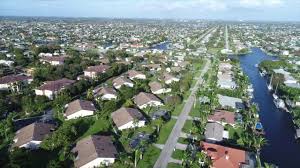
USA – Mangroves that were damaged one year ago due to botched maintenance work project by the city of Cape Coral will be replaced next weekend, weather permitting. Local non-profit group Keep Lee County Beautiful, in conjunction with the city and with 15 volunteers from the Cape Coral group “Citizens for the Preservation of Four Mile Cove” will plant 164 mangroves along the shoreline at Coral Pointe Canal on July 18. This is the last box on a checklist mandated by the Florida Department of Environmental Protection on what the city needed to do to remedy its July 2019 maintenance work that’s purpose, according to the city, was the removal of invasive exotic vegetation from the canal bank which impeded draining and restricted navigation. In the process, according to FDEP, they damaged mangroves, which are protected in Florida. Mike Thomas, program manager with Keep Lee County Beautiful said they were more than happy to take part in this replanting project.” READ MORE EUROPE
The carbon on your plate: mangrove and aquaculture

E.U. – One of the biggest threats to mangrove forests is the expansion of aquaculture ponds. Roughly 30 percent of mangrove deforestation and coastal land-use change in Southeast Asia has been attributed to aquaculture, especially shrimp farming. And as the top aquaculture commodity, the marine shrimp industry is forecast to continue its expansion, according to a report launched by Planet Tracker. Yet, somewhat ironically, deforestation may damage the shrimp industry, which the non-profit financial think tank says is worth $45 billion, globally. Coastal degradation and deforestation will make shrimp farms more prone to damage and diseases, resulting in higher operating costs and lower profit margins. Positive signs are emerging for ecologically conscious investors and as more countries and companies within the shrimp aquaculture sector have started to adopt deforestation-free value chain policies. The European Union, the biggest importer of shrimp from Southeast Asia, is a trendsetter in this regard. Pressures from investors are also key to achieving more sustainable, deforestation-free aquaculture, says Matthew McLuckie, director of Investor Relations at Planet Tracker. READ MORE LAST WORD Dear All, Please help spread the word on this year’s children’s mangrove art calendar competition! The contest is now open to anyone from any country between the ages of 6-15. Keep in mind, the deadline is Aug. 30th, so lets get those entries in ASAP! Do you know a budding artist or a gifted child? We would love to feature their vision of what the mangroves mean to them, our planet and their future. For more information, please visit Mangrove Action Project Calendar Project or download the PDF here Ciao,
Monica Quarto
monicagquarto@olympus.net
Like this newsletter?
Pease consider donating to MAP to keep it going.
Giving could never be easier | ACTION ALERTS Please SIGN: keep plantations out of orangutan habitat!
TAKE ACTION Unilever: stop destroying mangroves for convenience food! SIGN OUR PETITION Stop plundering the oceans for industrial aquaculture! SIGN THE PETITION Take action now and stop the build-out of coal plants in Bangladesh. Save Kakinada mangrove forest – Sign the Petition Enough! Pledging zero tolerance to attacks against environmental and human rights defenders. SIGN THE PETITION Like this newsletter? Pease consider donating to MAP to keep it going. Giving could never be easier 
CBEMR Training in Tanzania: Ground-breaking training breathes life into mangrove ecosystem restoration – The Mangrove Alliance Please see our newest video: ” Restoring The Natural Mangrove Forest” – https://youtu.be/Vh7CoPBLQa8 Mangrove Restoration Map VIEW MAP HERE 
Restoring The Natural Mangrove Forest
Watch movie 
Community Based Ecological Mangrove Restoration in Rufiji Delta VIEW VIDEO Video: Mangroves for the Future – A look bacK. As the latest phase of Mangroves for the Future (MFF) draws to a close, this video highlights some of the project’s most successful initiatives – from local women supporting national park management in Viet Nam to an island in the Maldives that has become a model for waste management, and everything in between. View Here WANT TO GET INVOLVED?
Follow and Join MAP!    
Like this newsletter? Pease consider donating to MAP to keep it going. Giving could never be easier 

VOLUNTEER OPPORTUNITY 
MANGROVE ISSUES Want to learn more about mangroves?
Our short presentation will give you a better understanding of the issues we are working to solve. WATCH PRESENTATION What is CBEMR? Download MAP’s 2 page CBEMR Information Sheet containing links to all MAP’s CBEMR resources – CLICK HERE What is EPIC? – The Ecosystems Protecting Infrastructure and Communities (EPIC) project: the role of ecosystems as protective barriers against climate induced hazards MANGROVES APP AVAILABLE
A pictorial field guide for easy identification of various mangrove species and learning about the mangroves ecosystem. CLICK HERE View MAP’s uploaded Videos at MAPmangrover’sChannel
Question Your Shrimp Consumer/Markets Campaign!
WATCH VIDEO WATCH – Mangroves: how they help the ocean
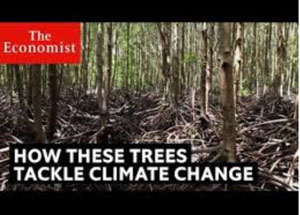 Mangrove Restoration in Asia – Watch Short Video The Value of Mangrove Forests View Video CBEMR Experience Exchange MAP 2017 English Subtitles
VIEW THE VIDEO Mangroves: Guidebook to Malaysia – Click Here
Mangrove rehabilitation in Asia – Local Action and cross-border Transfer of Knowledge for the Conservation of Climate, Forests and Biodiversity VIEW VIDEOS HERE SHARE MAP’S VISION
CLICK HERE to watch short introductory video. Together we can work “at the roots of the sea”. Our short documentary, Reducing the Risk of Disaster through Nature-Based Solutions : Mangroves

INTERVIEW – Yale Climate Connection interview with MAP’s Alfredo Quarto LISTEN Exclusive Interview with Alfredo Quarto, Co-Founder and Executive Director of Mangrove Action Project – See more
Marvellous Mangroves Curriculum The Marvellous Mangroves Education Forum is an online hub for those utilizing the Marvellous Mangroves (MM) Curriculum. It gives students, teachers and anyone interested in mangroves, the opportunity to learn and share ideas themed around the curriculum, to connect and communicate with others around the globe whilst exploring mangroves from your computer or on the go. VISIT 
The award-winning Marvellous Mangroves (MM) curriculum educates children on the importance of mangroves and their ecological functions, teaching them about modern challenges and mechanisms for sustainability. VIEW VIDEO Marvellous Mangroves Curriculum in Bangladesh – WATCH VIDEO
MARVELLOUS MANGROVES IN BRAZIL
En Portuges 
Marvellous Mangroves – A Curriculum-Based Teachers Guide. FOR MORE ON MAPs AWARD WINNING CHINA MANGROVE CURRICULUM VISIT

VIMEO SHOW
VISIT OUR “MM” WEBPAGE Check out our presentation for more details on Marvellous Mangroves Read this 10 page history of the development of MAP’s educational curriculum VIEW DOCUMENT
Article in Canada’s Green Teacher Magazine – Read More
Like this newsletter? Pease consider donating to MAP to keep it going. Giving could never be easier 
Green Planet Fundraising Assists MAP – LEARN MORE
Volunteer Opportunities with Mangrove Action Project CLICK HERE
“Question Your Shrimp” Campaign Question Your Shrimp- Don’t Buy or Sell Imported Tropical Shrimp! Sign the Petition Learn more about the affects of the shrimp industry on mangroves by visiting our blog
Editor’s Note: Mangrove Action Project’s Executive Director, Alfredo Quarto was interviewed about shrimp by Green Acre Radio’s Martha Baskin
LISTEN TO INTERVIEW Sign the Consumer’s Pledge to avoid imported shrimp
Not yet a MAP News subscriber?
Click here to subscribe. Note to Our Readers: We strive to keep active links in our newsletter. However, due to circumstances beyond our control, occasionally links to stories may become broken. If you find a link to a story is not functioning, please cut and paste the headline into your browser search bar. In most cases you should be able to locate the original story.
|



























